
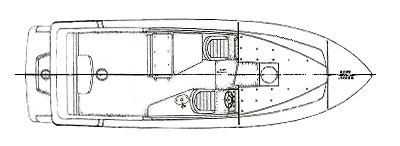 Another new boat from Monaro does not raise the eyebrows very much these days, and certainly this successful Richmond-based builder needs no introduction. However, this individual boat is another matter. Although based on their sleek and notably seakindly 24’ hull, this particular boat was built to accommodate complex, specialized equipment, plus it features a unique cockpit and interior layout. It is designed as model 255 which means it has been extended 18” from its original 24’. The extra length provides space for a will-appointed galley and dinette. The extension was accomplished by adding a pod at the lower transom area, increasing the waterline and adding buoyancy aft. The pod also serves as a robust outboard engine bracket to carry a pair of 130 hp Honda four-cycle engines. While the boat’s profile remains similar to the Monaro 24 in most respects, the stern pod and extended interior are unique.
Another new boat from Monaro does not raise the eyebrows very much these days, and certainly this successful Richmond-based builder needs no introduction. However, this individual boat is another matter. Although based on their sleek and notably seakindly 24’ hull, this particular boat was built to accommodate complex, specialized equipment, plus it features a unique cockpit and interior layout. It is designed as model 255 which means it has been extended 18” from its original 24’. The extra length provides space for a will-appointed galley and dinette. The extension was accomplished by adding a pod at the lower transom area, increasing the waterline and adding buoyancy aft. The pod also serves as a robust outboard engine bracket to carry a pair of 130 hp Honda four-cycle engines. While the boat’s profile remains similar to the Monaro 24 in most respects, the stern pod and extended interior are unique.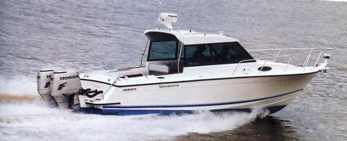
DESIGN This proven hull has a 20* deadrise aft which, combined with a fine entry, produces a dry ride. It's considered excellent for rough water. The hardtop is visually integrated with the overall design to retain the salty good looks of a sleek, if conservative, "contemporary classic." People who stand over 6' tall find there's ample headroom in a Monaro. Taller, longer windows in the cabin have improved all around visibility, yet retained stylish lines. Handrails and grabrails abound, making the boat look functional while enhancing the rakish styling.
The Monaro 255 has a straight sheerline sloping slightly downward from bow to stern. The deck rises at a slight angle from a flat forward surface over the low-profile roof of the forward cabin. A functional feature of a Monaro is its walk around deck – quite generous considering the size of the boat. Although the beam is a mere 8’, the side decks allow easy moving from cockpit to bow. Alternative access to the forward deck is via the cuddy cabin deck hatch.
CONSTRUCTION The Monaro hull is hand-laid fiberglass with a heavy skin coat of quality vinylester resin underlying top-of-the-line ISO-NPG gelcoat, followed by alternate layers of mat and 24-ounce roving. Bonded internal soft foam provides sound insulation and some emergency floatation. The three-part deck, cabin and inner liner are all-fibreglass with balsa coring used for the deck and hardtop. The liner includes the entire sole and bunks in one molded piece. In some areas, Monaro uses biaxial fiberglass – two layers of continuous uni-directional glass strands stitched together at 90* to one another.
Teak is used inside the boat for trim, paneling and finish, as well as on the stern gunwhales where the boat is normally boarded.
High quality, dense foam has been used in the upholstered seats and panels, ensuring they’ll retain their shape and support qualities for many years. Seat covers and panels are a premium vinyl. Stainless steel staples and fasteners are used throughout for these covers and removable panels.
Grabrails, bow and stern rails, and other safety grabs are one-piece welded stainless. The windshield is tempered safety glass, and a high-grade hatch is installed in the forward cabin. The oval portlights are stainless rimmed.
ON DECK The helm station affords excellent visibility through the higher than usual windows. There is comfortable seating for two in swivel seats at the helm and co-pilot positions. The driver has a robust footrest mounted on the bulkhead. A full width bench seat at the stern is comprised of several sections, and equipped with two hinged end bins and an open center which would be a perfect fit for a portable cooler. Loose cushions fit snugly atop the bins and center filler base. The backrest of this bench seat has cutouts at either end to accommodate the canvas camper top when it’s taken down and folded. Another bench is located aft of the helm position on the port side. It offers comfortable seating for two passengers, and can be altered quickly to face astern. When facing forward, it’s in the operational position and also serves as part of the dinette/forward social center when the helm and passenger seats are swiveled to face aft. This versatile bench seat also comprises part of the galley, because beneath it there’s a microwave oven.
Storage space is provided within a molded fiberglass step for the bench seat, and a raised, vinyl-covered shelf for the table. The builder thoughtfully included a hatch giving access to the water tank should the need ever arise.
There are two fuel tanks located amidships as well as a diesel tank for the Espar furnace. Access to the fuel tanks has been created by installing two inspection plates on the sole.
Large lockers open beneath the galley counter. Teak dish shelves are built in above the galley, and there are openings and more shelving for storage aft in the cockpit sides. Under the galley counter are large lockers with hinged doors and a single utensil drawer. Arborite counter tops surround the sink.
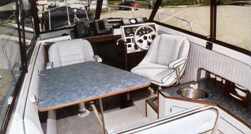
Padded vinyl covers the interior walls. A removable table top (stored in the forward cabin when not in use) can be fastened on the port side ahead of the bench seat to create the dinette.
The dash is a semi-custom unit because it incorporates a modified will or tray, sunk into the central portion for mounting electronics. This optional tray provides a less cluttered view over the dash and through the windshield.
Electronics and other dash equipment include a GPS with plotter, depth sounder/fish finder and autopilot as well as radar. An additional raised panel mounts special electronics, which support continuous computer-entry of simultaneous depth and location (GPS) data.
The Monaro 255’s windshield defogging system uses warm air from the bus heater, directed onto the inside of the glass through low-profile ducts in the dash. A convienent recessed side pocket/ storage shelf provides a place for storing items like sunglasses and logbook. To accommodate swivel seats at the helm, the throttle/gear shift lever unit needed to be recessed in the side panel, but it remains conveniently at hand. The same recess houses a radio, autopilot controls, tank monitors, furnace controls and other switches. Controls for a bow thruster are located on the lower dash to the left of the wheel. The boat also has a fuel flow meter which gives fairly accurate readings of fuel economy.
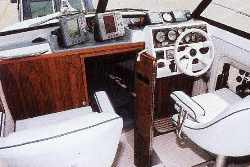
These sophisticated tools will assist in developing new methods needed to monitor and manage marine protected areas and other hidden portions of the ocean. The images are also of value to the Vancouver Aquarium Marine Science Center, because they will enable the public to better understand what they cannot see for themselves. Because many boat owners have a lifetime fascination for seafarining and fishing, they may have trouble comprehending just how little average citizens think or care about the ocean, simply because they cannot see beneath the surface.
The anchor and 400'- plus of anchor rope can be stored in the spacious bow locker of a standard Monaro 24. The 255 carries as much rope, but because the anchor is fixed on the bowsprit, not stowed in the anchor locker, there's more room for other items.
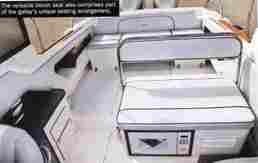
ACCOMODATION Access forward is through a centrally located doorway with a folding teak door set into the teak bulkhead. The door incorporates a full-height piano-hinge, so it’s base can fit within a compact well that’s recessed in the floor. In a standard 24, this well is normally much longer and extends aft adjacent to the galley. But the 255’s special configuration reduced available space, necessitating a hinged door. The resulting extra floor provides additional storage and locker space.
The cuddy has a full-length double berth with 6’5” bunk on which an adult can comfortably sit upright. There is a porta head under the vee. Large, wide fibreglassed-in shelving runs the length of the cabin and curves to the shape of the hull. These are used for storage as are the spacious bins under the bunks. This cuddy is finished in pleasant, warm shades of blue and soft greys.
UNDERWAY The Monaro 255 offers a smooth, comfortable ride with terrific visibility. I was thrilled with the centrally balanced Teleflex hydraulic steering-none of the usual pulling to one side or having to work harder steering one way than the other that is inherent with side-mounted steering rams. I originally topped the boat out conservatively at about 36 kts, not wanting to push the brand new 130hp Honda motors too hard. However, subsequent testing with a light load aboard revealed a top speed of 38 kts (43.7 mph) at 6000rpm. With three people and a full tank of fuel, this dropped slightly to 37.4 kts (43 mph), turning 5900 rpm,. The Monaro bumped only softly when crossing the wake of a large pleasure boat. In general, it feels rigid and safe. We ran up and down the tach feeling the acceleration onto plane and the slowing down to see how ell it would remain there. It could hold a plane down to a mere 11 kts at about 2200 rpm. It felt very comfortable in the lower 30 kt range turning 3200 to 3600 rpm. Fuel economy is about 6 gph at about 25 kts with a light load.
CONCLUSION This particular boat has been built for a specific purpose, but its configuration, in my view, should be standard for all small boats- a real winner. The boat runs and handles properly, offers an easy-maintenance fiberglass exterior, and the compact, comfortable interior is nicely equipped for serious boating.
